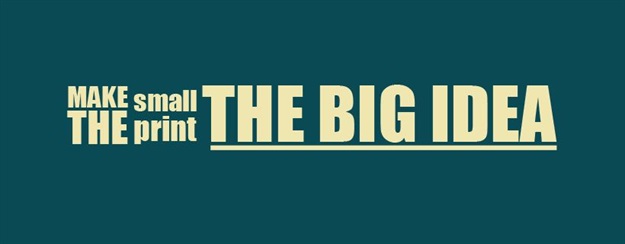5 ways to make the small print the big idea

In 1987 I spearheaded the first live South African television campaign - Price Busters for Hyperama - which aired every Friday on M-Net during Open Time. The Hyperama merchandise executives sold goods at great prices from the floor of a studio in Balfour Park with a microwave link to M-Net in Randburg! The offers were valid for two days only and the ROI measurable in real time.
Fast forward some three decades to One Lady & A Tribe’s latest advertising campaign where we did something similar but also unique. We positioned the “Dare to Compare” Campaign for Game Stores as “Taking the High Ground” on their most unique asset – the price beat promise in their small print. Leveraging off their important (but formerly low-key) price beat policy we elevated the promise - making it visible to the consumer and encouraging foot fall into stores.
Price beat is part of Game Stores retail DNA, having been around since the early 1970’s. It is a powerful promise which exists 365 days a year and is the only long-term promotion of its kind in South Africa. Up until “Dare to Compare” it had only been given marginal space in the tabloids and not used fully to entice customers. In other words, we used the small print and made it the big idea.
Here are five ways in which one can market a brand by highlighting an untapped offering. In the words of Walt Disney, “First, think. Second, believe. Third, dream. And finally, dare.”
1. Make it visible by leveraging off something critical but currently low key
The initial challenge of this is to find that key thing, the golden nugget about the business or product which will showcase its unique selling proposition. Then when you do, my advice is to use as few words as possible to advertise it and do it in the most compelling way. Be uber-confident and issue a challenge across all media channels showing how different your brand offer really is.
In the “Dare to Compare” campaign we elevated their price beat promise and tomake it highly visible to the consumer. Owning the fact that the brand welcomed bargain hunters to “bring it”,potential shoppers were encouraged to bring their cheaper price finds into store.
2. Make it meaningful by looking and sounding different
If you are not “outstanding” from other brands you don’t stand a chance. Think of George Kneller, who said, “To think creatively, we must be able to look afresh at what we normally take for granted.” Your campaign needs to look and sound different from anyone else in the market and if you manage to capture the attention of the potential customer in a daring, disruptive way you’re half way there.
For “Dare to Compare”, we used a simple, bold message, promising: “We’ll beat any price, so you get more with every shop.” This was carried through across omni-channel platforms including print ads, in taxi TV, on billboards and via social media.
3. Highlight the clear policy and speed of promise
If you’re making a unique brand promise it needs to be backed up with clarity of the policy and speedy interaction with the customer. In other words, it is vital to be authentic along with the offer.
For Game, the challenge to the consumer was clear: “We’ll beat any price, so you get more with every shop.” If the customer found any product cheaper they could head to the nearest store with the competitor’s leaflet. Game would not only match the price but beat it by 10% on the difference.
4. Make it fun rather than combative
Turn your campaign into a fun challenge through a cheeky marketing proposition. As David Ogilvy said, “Where people aren't having any fun, they seldom produce good work.” Keep in mind developing something with a competitive, rewarding, fun edge without being combative.
Show less product and using more clever tactical punch and talk-ability. For example, instead of featuring eight regular deals, offer three eye-catching, unbeatable offers to tantalise the customer and entice footfall into stores.
5. Deliver to the client, including the staff
As an advertiser the overall focus is on delivering improved ROI. This includes using your bold campaign as a motivator for sales merchants. This will also filter down to the consumers when they see how serious the business is about their unique policy.
Great brand assets are built over time with disciplined consistency. Focusing on a small brand or product promises is brave. It is a simple consumer proposition and it has proved its success. "There's too much smart-ass advertising today and not enough that emotionally moves consumers to go out and buy something", as one of my advertising heroes Mary Wells said.
As always our work is a group effort and making magic with me on the “Dare to Compare” campaign were the talented Michael Cook, Martin Sing and Didy Anderssson. Muchos thanks to everyone involved.

Sheila McGillivray, Tribe Leader
About: One Lady & A Tribe:
An ad agency. Just not your typical one. See, we know we don’t always have the answers. So we bring in amazing collaborators; designers, actors, techies, chefs, musicians, scientists, sports stars... and we combine their expertise with our own. We form a tribe. Together, we find the answers you’re looking for and create beautiful work that works.
Facebook: https://www.facebook.com/OneLadyandaTribe
Twitter: @1LadyandaTribe
Instagram: @oneladyandatribe